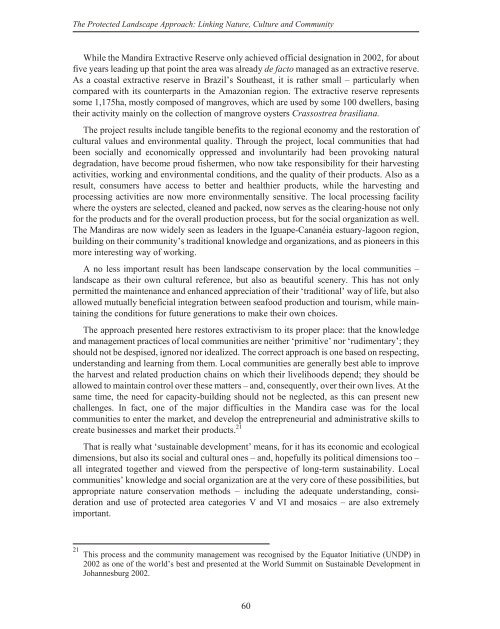The Protected Landscape Approach - Centre for Mediterranean ...
The Protected Landscape Approach - Centre for Mediterranean ...
The Protected Landscape Approach - Centre for Mediterranean ...
Create successful ePaper yourself
Turn your PDF publications into a flip-book with our unique Google optimized e-Paper software.
<strong>The</strong> <strong>Protected</strong> <strong>Landscape</strong> <strong>Approach</strong>: Linking Nature, Culture and Community<br />
While the Mandira Extractive Reserve only achieved official designation in 2002, <strong>for</strong> about<br />
five years leading up that point the area was already de facto managed as an extractive reserve.<br />
As a coastal extractive reserve in Brazil’s Southeast, it is rather small – particularly when<br />
compared with its counterparts in the Amazonian region. <strong>The</strong> extractive reserve represents<br />
some 1,175ha, mostly composed of mangroves, which are used by some 100 dwellers, basing<br />
their activity mainly on the collection of mangrove oysters Crassostrea brasiliana.<br />
<strong>The</strong> project results include tangible benefits to the regional economy and the restoration of<br />
cultural values and environmental quality. Through the project, local communities that had<br />
been socially and economically oppressed and involuntarily had been provoking natural<br />
degradation, have become proud fishermen, who now take responsibility <strong>for</strong> their harvesting<br />
activities, working and environmental conditions, and the quality of their products. Also as a<br />
result, consumers have access to better and healthier products, while the harvesting and<br />
processing activities are now more environmentally sensitive. <strong>The</strong> local processing facility<br />
where the oysters are selected, cleaned and packed, now serves as the clearing-house not only<br />
<strong>for</strong> the products and <strong>for</strong> the overall production process, but <strong>for</strong> the social organization as well.<br />
<strong>The</strong> Mandiras are now widely seen as leaders in the Iguape-Cananéia estuary-lagoon region,<br />
building on their community’s traditional knowledge and organizations, and as pioneers in this<br />
more interesting way of working.<br />
A no less important result has been landscape conservation by the local communities –<br />
landscape as their own cultural reference, but also as beautiful scenery. This has not only<br />
permitted the maintenance and enhanced appreciation of their ‘traditional’ way of life, but also<br />
allowed mutually beneficial integration between seafood production and tourism, while main -<br />
taining the conditions <strong>for</strong> future generations to make their own choices.<br />
<strong>The</strong> approach presented here restores extractivism to its proper place: that the knowledge<br />
and management practices of local communities are neither ‘primitive’ nor ‘rudimentary’; they<br />
should not be despised, ignored nor idealized. <strong>The</strong> correct approach is one based on respecting,<br />
understanding and learning from them. Local communities are generally best able to improve<br />
the harvest and related production chains on which their livelihoods depend; they should be<br />
allowed to maintain control over these matters – and, consequently, over their own lives. At the<br />
same time, the need <strong>for</strong> capacity-building should not be neglected, as this can present new<br />
challenges. In fact, one of the major difficulties in the Mandira case was <strong>for</strong> the local<br />
communities to enter the market, and develop the entrepreneurial and administrative skills to<br />
create businesses and market their products. 21<br />
That is really what ‘sustainable development’ means, <strong>for</strong> it has its economic and ecological<br />
dimensions, but also its social and cultural ones – and, hopefully its political dimensions too –<br />
all integrated together and viewed from the perspective of long-term sustainability. Local<br />
communities’ knowledge and social organization are at the very core of these possibilities, but<br />
appropriate nature conservation methods – including the adequate understanding, con si -<br />
deration and use of protected area categories V and VI and mosaics – are also extremely<br />
important.<br />
21 This process and the community management was recognised by the Equator Initiative (UNDP) in<br />
2002 as one of the world’s best and presented at the World Summit on Sustainable Development in<br />
Johannesburg 2002.<br />
60

















